Unlocking Research Efficiency: A Guide to the Best Research Paper Summarizers
Drowning in a sea of research papers? Need to extract key insights quickly? This listicle presents 12 powerful research paper summarizer tools designed to streamline your academic workflow. From seasoned researchers to high school seniors preparing for college, anyone navigating the complexities of academic literature will benefit from these tools. We'll explore the features, pricing, pros, and cons of each, drawing from extensive, real-world usage. Discover which tools excel at specific tasks, and understand their limitations to make informed decisions about which one best suits your research needs. This guide will help you unlock research efficiency and reclaim valuable time. As AI becomes more prevalent in research, it's worth considering the long-term career implications. For insights into future-proof career paths, check out this resource on AI Proof Jobs. This guide covers the following research paper summarizers:
- SmartStudi
- Paperguide
- Tenorshare AI PDF Tool
- Elicit
- QuillBot
- Semantic Scholar
- IBM Watson Discovery
- SciSummary
- SummarizeBot
- Copernic Summarizer
- Resoomer
- TLDR This
1. SmartStudi
SmartStudi targets the academic needs of college students, high school seniors, and young adults. Its core feature is an AI-powered research paper summarizer designed to condense lengthy articles into concise summaries. Beyond summarization, SmartStudi offers a comprehensive suite of tools, including a plagiarism checker updated daily, a paraphrasing tool dubbed the "humanizer," and even an AI chatbot for generating original content. This makes it a potential one-stop shop for academic writing and research. If you need to quickly generate a professional headshot for your academic profile, check out these AI headshot generators. They offer an easy way to create a polished image.
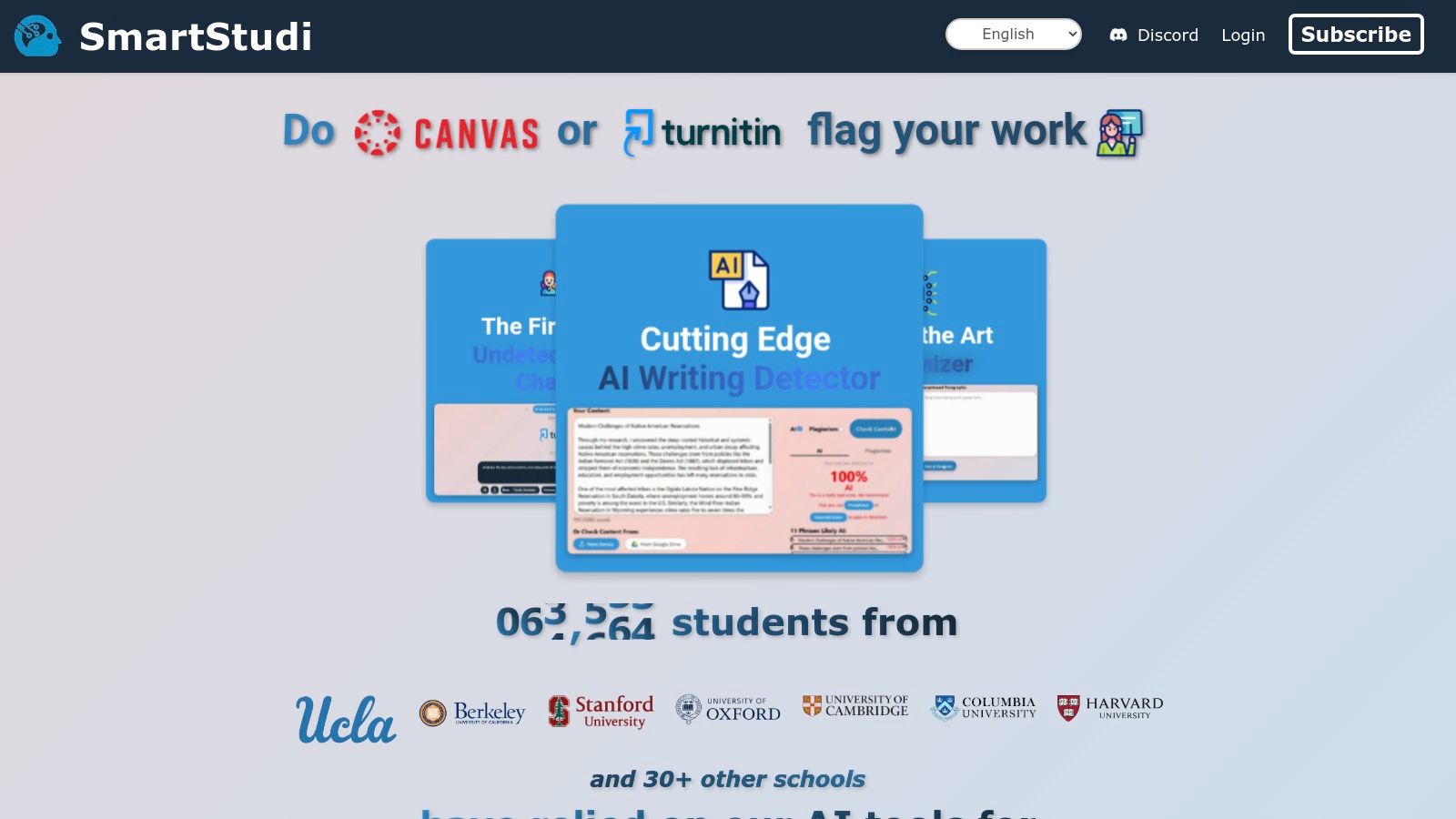
SmartStudi's research paper summarizer allows students to quickly grasp the key concepts of complex research articles, saving valuable study time. Learn more about SmartStudi and its features. Its integrated citation generator, capable of handling up to 20 citations simultaneously, streamlines the often tedious process of referencing sources. The built-in grammar checker offers an additional layer of polish to ensure high-quality writing.
Pros and Cons
Pros:
- Comprehensive Toolset: Offers a range of features beyond summarization, including plagiarism checking, paraphrasing, and AI content generation.
- Up-to-Date Plagiarism Detection: The plagiarism checker is continuously updated, improving accuracy and reliability.
- Efficient Citation Generation: Simplifies referencing with batch citation processing.
Cons:
- Pricing Opacity: Subscription details require account creation, making it difficult to compare costs upfront.
- Niche Focus: The toolset is primarily geared towards academic writing, potentially limiting its broader applicability.
While SmartStudi shows great promise for students, the lack of transparent pricing is a drawback. Its focused feature set, while beneficial for academic tasks, might not cater to users with broader writing needs. However, its strengths lie in its comprehensive approach to academic support, integrating various essential tools into a single platform.
2. Paperguide
Paperguide is a versatile research platform designed to simplify the process of extracting key insights from dense academic PDFs. It offers a suite of tools for managing references, annotating documents, and even querying complex academic concepts, significantly improving study efficiency and note preparation. This makes it an invaluable tool for students and researchers grappling with large volumes of information. It speeds up data extraction and provides insightful analysis, allowing users to quickly grasp the core arguments of research papers.

Paperguide's research paper summarization capabilities enable users to quickly identify the most relevant information within a document. Its reference management features streamline the often tedious process of organizing citations. The platform also enhances study sessions with its annotation and note-taking tools, facilitating a more interactive and engaging learning experience. Learn more about Paperguide.
Pros and Cons
Pros:
- Accelerated Research: Quickly identifies relevant information within research papers, saving valuable time.
- Improved Organization: Streamlines the management of references and citations.
- Interactive Learning: Facilitates deeper comprehension through annotation and note-taking features.
Cons:
- Learning Curve: Utilizing the full range of features may require some initial learning and practice.
- Pricing: Specific pricing details are not readily available publicly.
While Paperguide offers a powerful set of tools for researchers, the lack of transparent pricing information is a notable drawback. However, its focus on enhancing research efficiency and facilitating deeper comprehension makes it a strong contender for anyone working with academic literature. Its ability to manage references seamlessly is a particularly valuable asset for students and researchers alike.
3. Tenorshare AI PDF Tool
Tenorshare AI PDF Tool leverages AI to summarize research papers, condensing lengthy articles into concise overviews. Its interactive chat, powered by ChatGPT, allows users to query PDFs for specific information. This tool is particularly useful for students needing to quickly grasp key concepts from multiple research papers. The batch processing feature further enhances efficiency when dealing with numerous documents.

Tenorshare AI PDF Tool not only summarizes content but also automatically extracts key sections like the abstract, methodology, results, and conclusions. This streamlines literature reviews by quickly highlighting crucial information. The secure platform, utilizing SSL encryption and file deletion, adds a layer of privacy for users handling sensitive research materials. While specific pricing isn't readily available, the tool's features make it a strong contender for efficient research paper summarization.
Pros and Cons
Pros:
- Time-Saving Summaries: Quickly condenses lengthy research papers.
- Interactive Chat Interface: Facilitates deeper understanding through targeted queries.
- Efficient Batch Processing: Handles multiple PDFs simultaneously.
Cons:
- Connectivity Reliance: Likely requires internet access for full functionality.
- Pricing Opacity: Publicly available pricing details are lacking.
Tenorshare AI PDF Tool stands out for its interactive chat feature, allowing users to engage directly with the content. While the lack of transparent pricing is a drawback, its AI-driven summarization and batch processing capabilities offer valuable time savings for researchers. Its focus on PDF interaction makes it a practical choice for those working extensively with this document format.
4. Elicit
Elicit is an AI-powered research assistant designed to streamline the process of academic research. It excels at understanding context and meaning in search queries, delivering more relevant results than keyword-based searches. Elicit provides automatic summaries, giving researchers a quick overview of key findings. It also offers detailed insights into research methodologies and outcomes, useful for critically evaluating studies.

Elicit's intelligent search filters and sorting options allow for refined results, focusing on specific aspects of research like participant demographics or intervention types. This targeted approach saves researchers significant time compared to manually sifting through countless articles. For those working with PDFs, many tools like PDFeditify offer features to manage and edit these documents, further streamlining the research workflow. Elicit's inline referencing feature promotes transparency and simplifies the citation process, reducing the risk of plagiarism. While tools like Tenorshare AI PDF Tool focus on PDF manipulation, Elicit targets the entire research discovery and summarization process.
Pros and Cons
Pros:
- Efficient Research: Quickly identifies relevant papers through context-aware searching.
- Concise Summaries: Saves reading time with automatically generated summaries.
- Detailed Insights: Provides in-depth information on methodologies and outcomes.
Cons:
- Discipline Coverage: May not comprehensively cover all academic disciplines.
- Pricing: Specific pricing information is not readily available.
Elicit demonstrates considerable potential as a research paper summarizer, especially for those seeking in-depth insights beyond basic summaries. However, the lack of transparent pricing and potential limitations in disciplinary coverage warrant consideration. Its focus on context and meaning in search queries offers a substantial advantage over traditional keyword-based research methods.
5. QuillBot
QuillBot is an AI-powered writing platform featuring a research paper summarizer designed to condense lengthy articles into concise summaries. It offers customizable summary length (short or long) and output formats (paragraph or bullet points), making it adaptable to different research needs. QuillBot integrates seamlessly with its other writing enhancement tools, such as the Paraphraser and Grammar Checker, creating a streamlined writing workflow. Learn more about how AI writing tools can transform your essays at QuillBot.
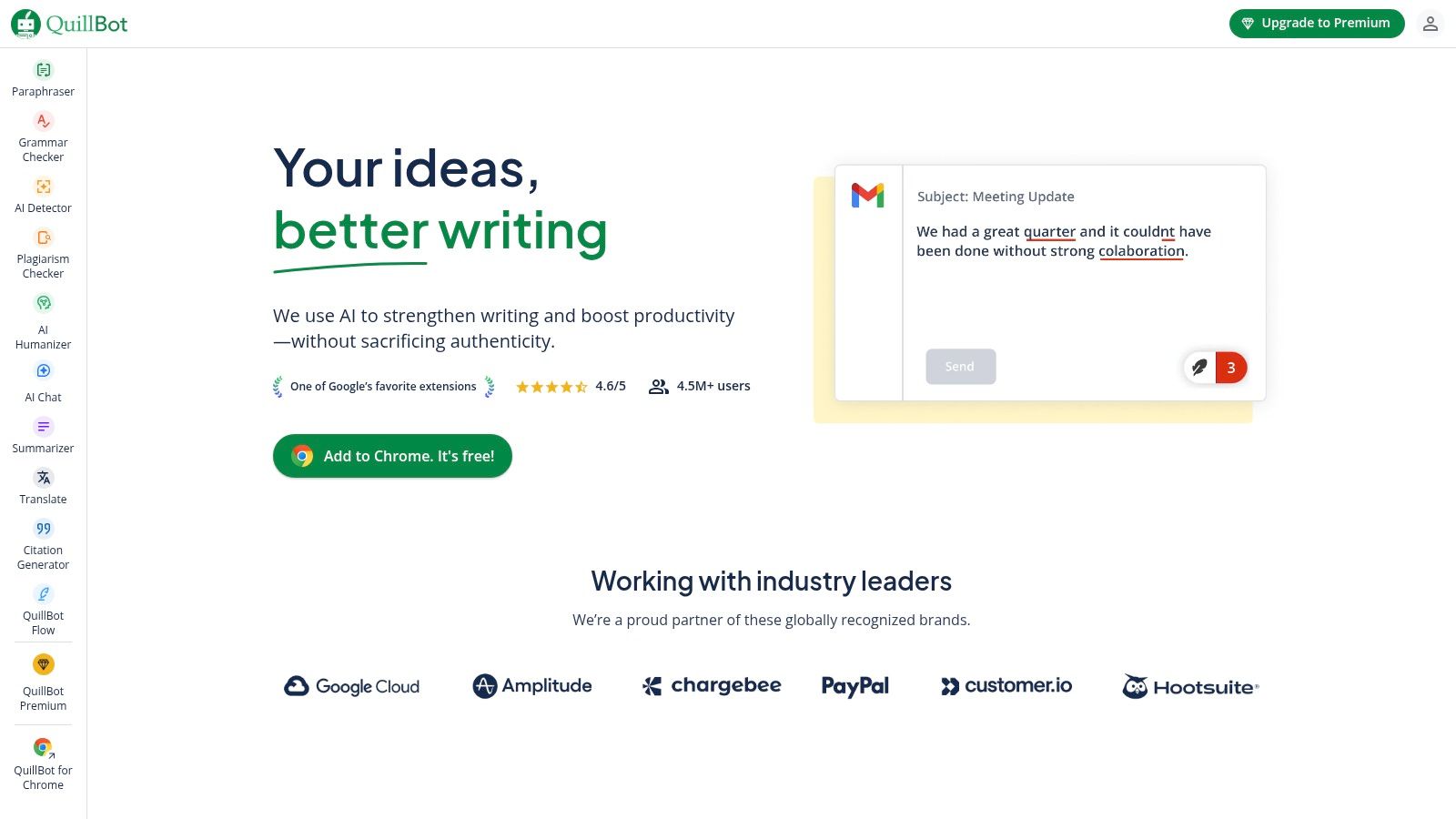
QuillBot's summarizer excels at quickly extracting key concepts from research papers, improving reading comprehension and saving valuable study time. Its flexible output formats allow users to tailor summaries to their specific needs, whether it's a quick overview in bullet points or a more detailed paragraph summary. The integration with other QuillBot tools enhances the overall writing process, allowing for seamless transitions between summarizing, paraphrasing, and grammar checking.
Pros and Cons
Pros:
- User-Friendly Interface: The platform is intuitive and easy to navigate, even for first-time users.
- Flexible Summarization Options: Customizable summary lengths and output formats cater to diverse needs.
- Integrated Writing Tools: Seamless integration with paraphrasing and grammar checking features enhances writing efficiency.
Cons:
- Word Limit in Free Version: The free version has limitations on the word count for summarization.
- Premium Cost: Unlocking the full potential of QuillBot requires a premium subscription, which might be a barrier for some.
QuillBot presents a valuable tool for students and researchers seeking to efficiently summarize research papers. While the free version offers a glimpse into its capabilities, the premium features provide significant added value. The user-friendly interface and integrated toolset contribute to a streamlined and productive writing experience.
6. Semantic Scholar
Semantic Scholar is a free, AI-powered research tool specifically designed for scientific literature. It excels at providing concise, one-sentence summaries of research papers and highlighting the most influential citations. This allows researchers to quickly grasp the core findings of a paper and assess its impact within the field. Beyond summarization, Semantic Scholar offers personalized recommendations through its Research Feed, helping users stay up-to-date with relevant publications.
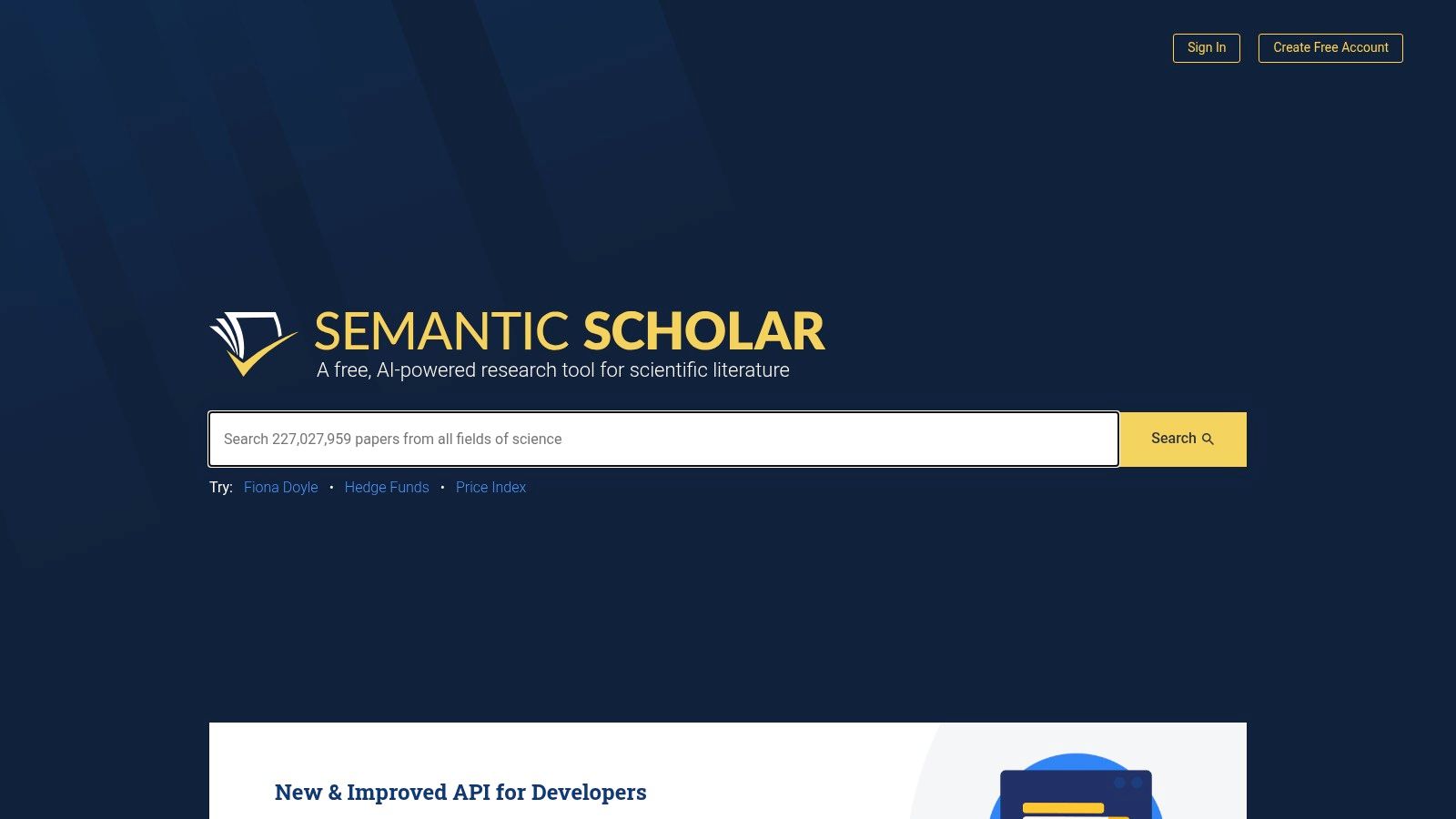
Semantic Scholar's Semantic Reader feature further enhances the research process. It provides in-line citation cards and highlights, streamlining navigation and understanding of complex research papers. Users can also manage their personal libraries within the platform, saving and organizing papers for future reference. This makes it an invaluable tool for literature reviews and keeping track of key research in a specific area. Learn more about Semantic Scholar.
Pros and Cons
Pros:
- Free Access: Provides access to a vast collection of scientific literature without any cost.
- Efficient Summarization: Quickly grasp key concepts with concise summaries and citation analysis.
- Personalized Recommendations: The Research Feed keeps users informed about relevant new publications.
Cons:
- Discipline Coverage: May not offer comprehensive coverage across all academic disciplines.
- Summary Depth: One-sentence summaries may lack depth for highly complex or nuanced papers.
While Semantic Scholar is a powerful tool for researchers, its focus on scientific literature might limit its use for those in other fields. The concise summaries, while efficient, may not always provide the full context needed for deeply technical or nuanced research papers. However, its free access and personalized recommendations make it a valuable resource for staying updated in scientific domains.
7. IBM Watson Discovery
IBM Watson Discovery is an AI-powered research paper summarizer designed for analyzing large volumes of data. It goes beyond simple summarization by understanding context, concepts, and relationships within the text. This allows Watson Discovery to uncover hidden patterns and connections, making it a powerful tool for in-depth research. It's particularly useful for students tackling complex research projects or anyone needing to quickly synthesize information from multiple sources.

Watson Discovery offers customizable queries and filtering. This allows researchers to tailor summaries to their specific needs. Its relationship identification feature highlights important entities and topics, further enhancing comprehension. By automating the information discovery process, Watson Discovery saves valuable research time. While powerful, it may require some technical expertise to fully utilize its capabilities.
Pros and Cons
Pros:
- Uncovers Hidden Insights: Identifies patterns and connections that might be missed with manual review.
- Customization: Allows for tailored queries and filtering to focus on specific research areas.
- Efficient for Large Datasets: Handles substantial volumes of data effectively.
Cons:
- Technical Expertise: May require coding or technical knowledge for optimal use and integration.
- Pricing: Specific pricing details aren't readily available, requiring direct contact with IBM.
IBM Watson Discovery stands out for its advanced cognitive capabilities, going beyond basic summarization to reveal deeper insights. However, its complexity might pose a challenge for users without technical experience. The lack of transparent pricing is also a drawback. Learn more about IBM Watson Discovery.
8. SciSummary
SciSummary leverages the power of GPT-3.5 and GPT-4 to deliver comprehensive summaries of scientific papers. Its unique approach involves emailing your research paper (text, link, or PDF) to SciSummary, and receiving a concise summary in your inbox within minutes. This asynchronous approach can be a great time-saver for researchers needing a quick overview of dense scientific articles. If your research involves multiple sources and citations, a tool like SmartStudi's citation generator might help. Learn more about citation generators and their benefits.
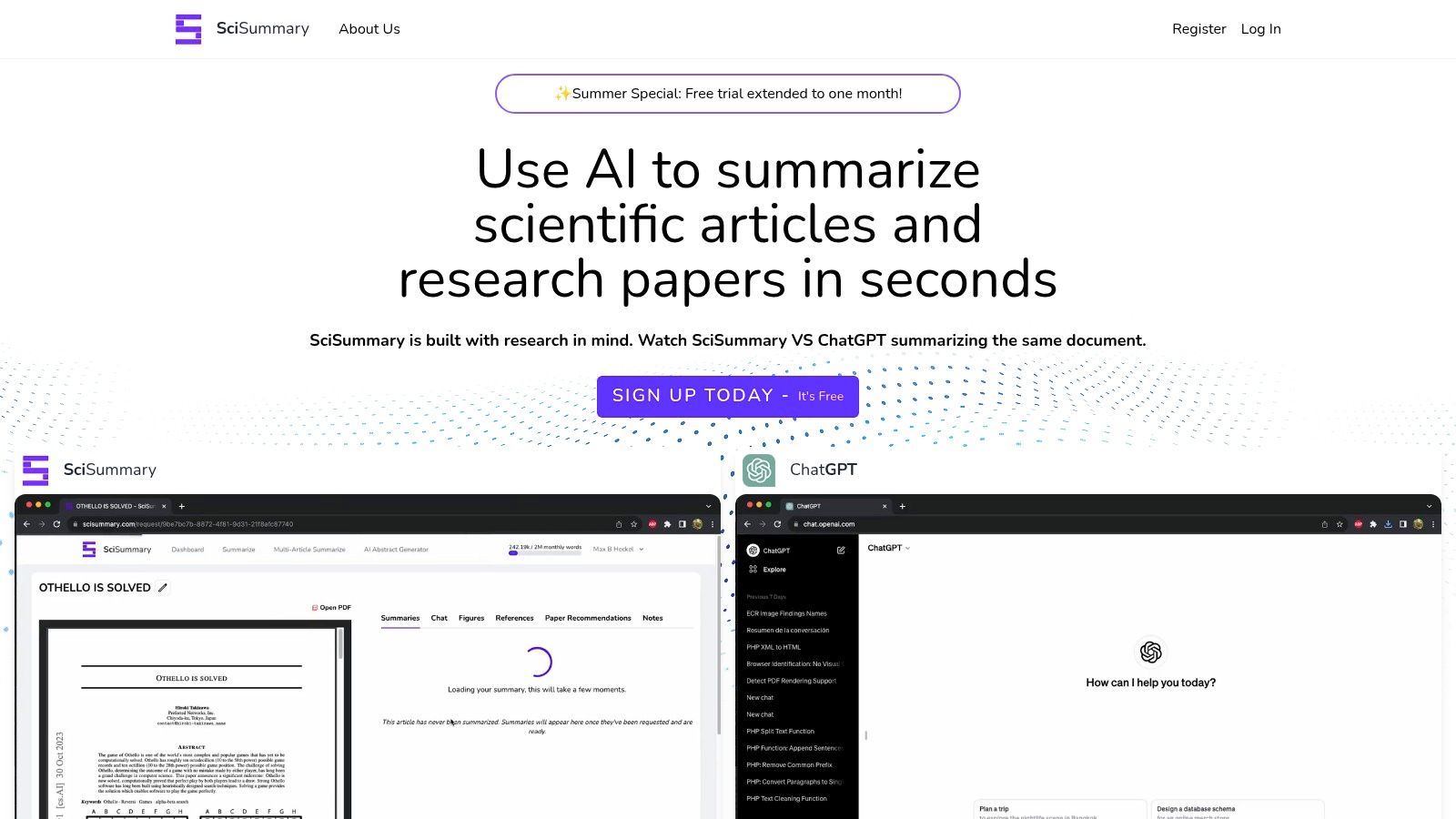
SciSummary streamlines the process of digesting complex scientific literature by utilizing advanced AI language models. This email-based system provides a convenient, hands-off approach to obtaining research paper summaries. Its focus on scientific papers makes it a specialized tool for researchers, students, and professionals in scientific fields. This targeted approach helps to optimize the AI models for accuracy and relevance within scientific literature.
Pros and Cons
Pros:
- Simplified Summarization: Easily obtain summaries of scientific articles without manual effort.
- Advanced AI Integration: Leverages the power of GPT-3.5 and GPT-4 for accurate and comprehensive summaries.
- Convenient Submission: Email-based submission offers a simple and asynchronous workflow.
Cons:
- Email Dependence: Reliance on email might not be ideal for users preferring direct platform interaction.
- Scientific Focus: Primarily designed for scientific articles, limiting its applicability to other document types.
SciSummary’s distinct email-based approach distinguishes it from other research paper summarizers. While the reliance on email might be a minor inconvenience for some, its specialized focus on scientific literature allows for highly accurate and relevant summaries using powerful AI models. This makes SciSummary a valuable tool for anyone navigating the dense world of scientific research.
9. SummarizeBot
SummarizeBot leverages AI and blockchain technology to summarize various content types, including research papers, documents, web links, and even images. Its standout feature is the ability to customize summary lengths, offering flexibility for different research needs. This, combined with no word or daily usage limits, makes it a valuable tool for students and researchers looking for a free and versatile summarization solution.

SummarizeBot's ability to handle diverse formats like PDFs and images sets it apart from many research paper summarizers. This versatility makes it useful not only for condensing articles but also for quickly extracting key information from other sources. While it offers customization in summary length, finer control over aspects like the focus of the summary would further enhance its utility. Learn more about SummarizeBot.
Pros and Cons
Pros:
- Versatile Content Handling: Processes various formats including text, PDFs, and images.
- User-Friendly and Unlimited: Free to use with no restrictions on word count or daily usage.
- Customizable Summary Length: Allows users to tailor the summary length to their needs.
Cons:
- Nuance Challenges: May struggle to capture the subtleties and nuances of complex research papers.
- Limited Customization: While summary length is adjustable, other customization options are limited.
SummarizeBot's free and unlimited usage makes it an attractive option for students on a budget. However, users dealing with highly technical or nuanced research papers should be aware of its potential limitations in capturing complex arguments. Its strength lies in its versatility and ease of use, making it a good starting point for quickly summarizing various content formats.
10. Copernic Summarizer
Copernic Summarizer focuses on condensing documents and web pages into concise summaries using statistical and linguistic algorithms. This software application supports multiple languages and allows for customizable summary lengths, making it a versatile tool for quickly grasping the core ideas of various text formats. It's particularly useful for students and researchers needing to digest large volumes of information efficiently. Copernic handles various file types, including PDFs and Word documents, directly addressing common academic file formats.
Copernic Summarizer's strength lies in its efficient document condensation. You can quickly extract key information from lengthy research papers or articles, saving valuable time. Its multilingual support broadens its applicability to international research and diverse language sources. The customizable summary length allows users to tailor the output to their specific needs, whether a brief overview or a more detailed synopsis.
Pros and Cons
Pros:
- Efficient Document Condensation: Quickly summarizes large volumes of text.
- Multilingual Support: Handles various languages for broader application.
- Flexible Summary Customization: Control over summary length and detail.
Cons:
- Dated Interface: The user interface may feel outdated compared to newer tools.
- Accuracy with Complex Research: Can struggle with nuanced or highly technical research papers, potentially missing critical subtleties.
While Copernic Summarizer offers efficient summarization for various document types, its user interface may feel somewhat dated. Accuracy can be a concern with highly complex research papers, requiring careful review of the generated summaries. However, its customization options and multilingual support make it a valuable tool for those seeking efficient document condensation. Learn more about Copernic Summarizer.
11. Resoomer
Resoomer is an online text summarizer using AI to create concise summaries in multiple languages. This makes it a valuable tool for students and researchers working with documents in various languages. Its ability to customize summary length allows users to control the level of detail, catering to different research needs. Resoomer integrates with research tools like Google Scholar and Mendeley, streamlining the research workflow. This integration allows for seamless summarization of research papers found through these platforms.
Resoomer's research paper summarizer lets students quickly grasp the core arguments of lengthy articles, which is crucial for efficient studying. Its multilingual support is particularly helpful for students engaging with international research. The integration with Google Scholar and Mendeley directly addresses a key pain point in academic research: managing and synthesizing information from numerous sources. Learn more about Resoomer.
Pros and Cons
Pros:
- Multilingual Support: Summarizes text in various languages, broadening its applicability.
- Customizable Summaries: Users can adjust the length of the summary to fit their needs.
- Research Tool Integration: Seamlessly works with Google Scholar and Mendeley.
Cons:
- Limitations in the Free Version: The free version may restrict usage or features.
- Long Document Challenges: The tool might struggle with very long or complex documents.
Resoomer's value lies in its accessibility and integration with existing research workflows. While the free version may have some limitations, its core functionality is valuable for students and researchers needing quick summaries of research papers, especially those in different languages. However, its potential struggles with very long documents should be considered when dealing with extensive research materials. The ability to customize summary length adds a layer of control, allowing users to tailor the summaries to their specific requirements.
12. TLDR This
TLDR This is a free, AI-powered online research paper summarizer. It's designed to condense lengthy articles into manageable summaries, offered in multiple lengths and languages. Users can simply input a URL or paste text directly. The tool then generates a summary formatted as bullet points or a paragraph, providing flexibility depending on the user's preference. This straightforward functionality makes it a quick and easy option for students and researchers needing a rapid overview of a paper.
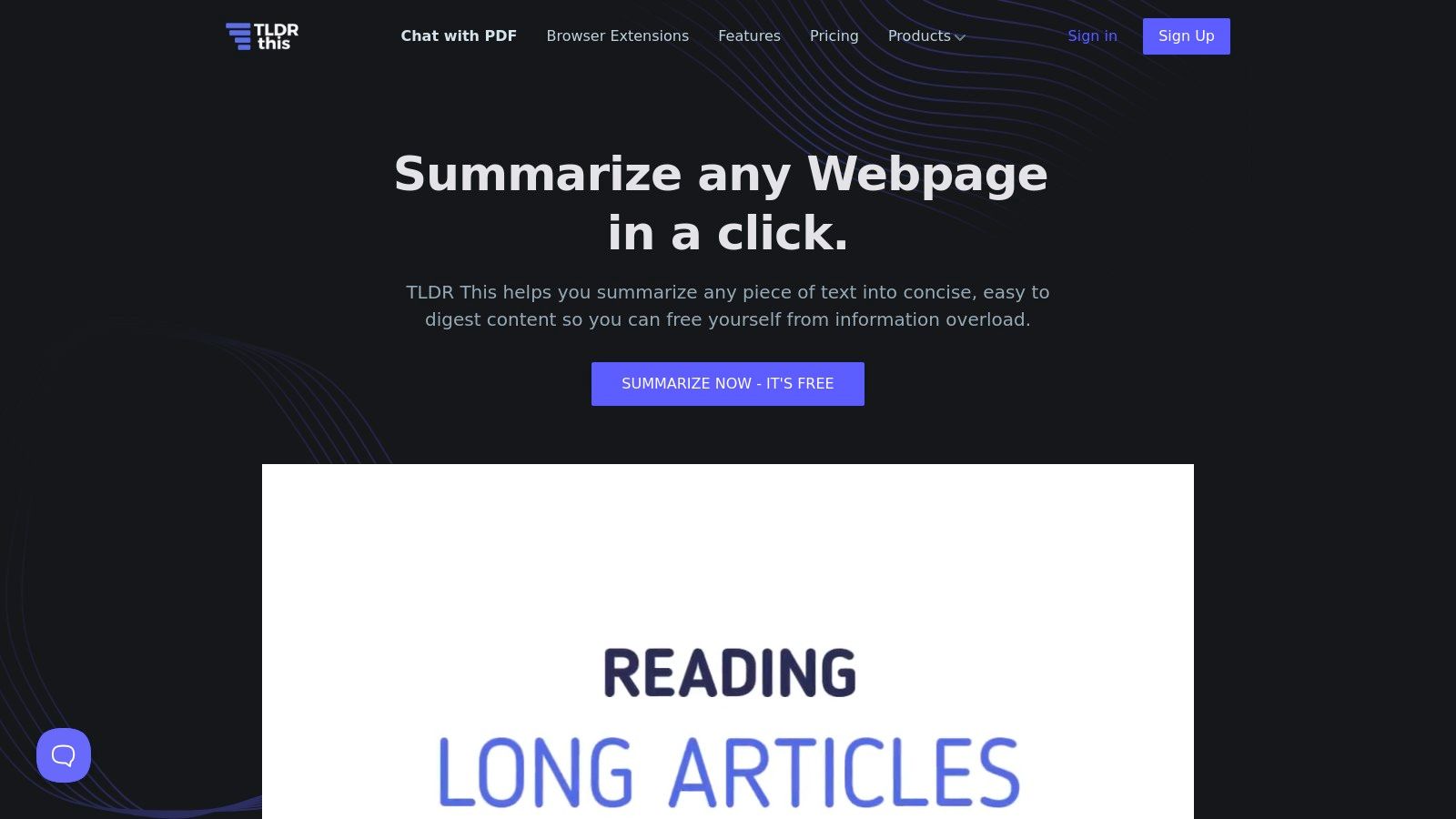
TLDR This shines in its simplicity and speed. It's particularly useful for getting the gist of multiple research papers quickly, for example, when reviewing literature for a research project. The ability to choose between bullet points and paragraph summaries adds to its practicality. The multi-language support is a significant advantage for international students or researchers working with foreign language texts. Learn more about TLDR This.
Pros and Cons
Pros:
- User-Friendly Interface: Easy to navigate and use, even for first-time users.
- Multiple Language Support: Facilitates summarization of research in various languages.
- Customizable Summary Length: Allows users to control the level of detail in the summary.
Cons:
- Accuracy with Technical Papers: May struggle with highly specialized or technical content, potentially missing nuances.
- Limited Customization Options: Provides less control over the content of the summary beyond length and format.
TLDR This is a valuable free tool for quickly summarizing research papers. While it may not be ideal for highly technical articles, its ease of use and multi-language support make it a practical option for many research and academic tasks. The free access eliminates any cost barrier, making it a readily available resource for students and researchers.
Research Paper Summarizer Tools Comparison
| Product | Core Features/Characteristics | User Experience / Quality ★ | Value Proposition 💰 | Target Audience 👥 | Unique Selling Points ✨ |
|---|---|---|---|---|---|
| 🏆 SmartStudi | AI & plagiarism detector, advanced paraphraser, AI chatbot | ★★★★★ Highly accurate & reliable | 💰 Subscription (details upon sign-up) | 👥 Students (18-25), academics | ✨ Undetectable AI chatbot, daily detector updates, full academic toolkit |
| Paperguide | PDF research extractor, reference management, annotation tools | ★★★★ Efficient but with learning curve | 💰 Pricing not public | 👥 Researchers, students | ✨ Interactive queries, annotation & note prep |
| Tenorshare AI PDF Tool | AI summarization, ChatGPT-powered chat, batch PDF processing | ★★★★ Saves time, interactive | 💰 Pricing not public | 👥 Researchers, students | ✨ Batch processing, secure SSL & file deletion |
| Elicit | Context-aware search, auto summaries, inline referencing | ★★★★ Quick, insightful summaries | 💰 Pricing not public | 👥 Academic researchers | ✨ Intelligent understanding, detailed methodological insights |
| QuillBot | AI summarizer, paraphrasing, grammar checker integration | ★★★★ User-friendly, flexible | 💰 Free + premium (costly for some) | 👥 Writers, students | ✨ Custom summary length & format, multi-tool integration |
| Semantic Scholar | Concise one-sentence summaries, citation influence detection | ★★★★ Broad research coverage | 💰 Free | 👥 Researchers, students | ✨ Personalized recommendations, Semantic Reader |
| IBM Watson Discovery | Contextual data analysis, customizable queries, pattern uncover | ★★★★ Powerful but complex | 💰 Pricing not public | 👥 Enterprise, researchers | ✨ Cognitive context & relationships, big data handling |
| SciSummary | GPT-3.5/4 AI summaries via email submission | ★★★★ Accurate, convenient | 💰 Free / paid tiers unspecified | 👥 Scientific article readers | ✨ Email-based summary requests, multi-input support |
| SummarizeBot | Summarizes text, PDFs, images; customizable length | ★★★★ Unlimited free usage | 💰 Free | 👥 General users, students | ✨ No limits, multi-format support |
| Copernic Summarizer | Multi-language, statistical & linguistic summarization | ★★★ Efficient but outdated UI | 💰 One-time software purchase | 👥 General document users | ✨ Multilingual, customizable summaries |
| Resoomer | Multilingual AI summarization, integration with scholar tools | ★★★★ Good but limited free version | 💰 Free with upgrade options | 👥 Students, researchers | ✨ Google Scholar & Mendeley integration |
| TLDR This | AI summaries in multiple formats and languages | ★★★★ Easy to use | 💰 Free | 👥 Students, casual researchers | ✨ Bullet point and paragraph summary formats |
Choosing the Right Research Paper Summarizer for Your Needs
Finding the perfect research paper summarizer from a sea of options can feel daunting. This listicle has explored twelve distinct tools, each with its own strengths and weaknesses. From established platforms like IBM Watson Discovery to streamlined options like TLDR This, the ideal choice depends entirely on your individual research needs. Remember to consider factors like your technical comfort level, budget constraints, and the typical length and complexity of the papers you analyze.
Key Takeaways and Considerations
The tools discussed offer diverse approaches to summarizing research papers. Some, like Semantic Scholar, excel at contextualizing research within a broader academic field. Others, like SummarizeBot, prioritize speed and simplicity. QuillBot provides paraphrasing capabilities, while tools like Tenorshare AI PDF Tool focus on PDF manipulation and extraction. Keeping these core functionalities in mind is crucial for selecting the right tool.
Here’s a quick recap of important factors to consider:
- Accuracy: How reliably does the tool capture the core arguments and findings?
- Speed: How quickly can it generate a summary?
- Features: Does it offer additional functionalities like paraphrasing, citation extraction, or topic modeling?
- Ease of Use: How intuitive is the interface?
- Cost: Does the pricing model align with your budget and usage frequency?
- Input Formats: Does it support the file types you typically work with (PDF, DOCX, etc.)?
Implementing Research Paper Summarizers Effectively
Successfully integrating a research paper summarizer into your workflow requires more than just selecting the right tool. You must also develop a critical approach to the summaries generated. Remember, these tools are designed to assist, not replace, human comprehension. Always review and verify key information from the original source.
- Start with a Clear Objective: Define what you want to achieve with the summarizer. Are you looking for a quick overview, key takeaways, or a detailed synopsis?
- Critically Evaluate Summaries: Treat summaries as a starting point, not the final word. Verify crucial details against the original paper.
- Combine with Other Research Strategies: Use summarizers alongside traditional reading and note-taking methods for a comprehensive understanding.
Finding the Perfect Fit
The "perfect" research paper summarizer doesn't exist universally. It's the tool that best aligns with your specific requirements. For students juggling multiple assignments, a fast and easy-to-use tool like Resoomer might be ideal. Researchers delving into complex topics might benefit from the depth offered by Elicit or the contextualization provided by Semantic Scholar. By carefully considering your needs and exploring the features of each tool, you can transform your research process.
From quickly grasping key concepts to efficiently reviewing large volumes of literature, a well-chosen research paper summarizer can be an invaluable asset. Embrace these tools as powerful allies in your academic journey, empowering you to navigate the world of research with greater speed, efficiency, and insight.
Looking for a comprehensive platform to supercharge your academic journey? SmartStudi offers a suite of tools, including research assistance, to help you excel in your studies. Explore the possibilities and elevate your learning experience by visiting SmartStudi.
